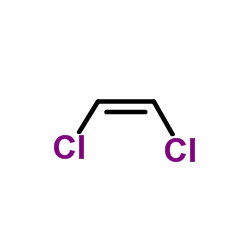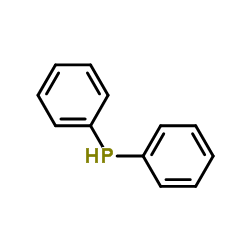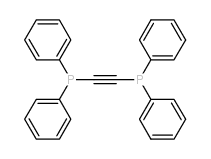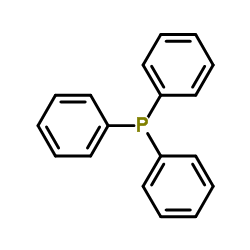cis-1,2-Bis(diphenylphosphine)ethene
Modify Date: 2024-01-11 12:16:59
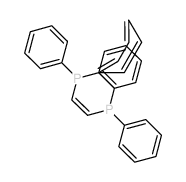
cis-1,2-Bis(diphenylphosphine)ethene structure
|
Common Name | cis-1,2-Bis(diphenylphosphine)ethene | ||
|---|---|---|---|---|
| CAS Number | 983-80-2 | Molecular Weight | 396.40000 | |
| Density | N/A | Boiling Point | 546.8ºC at 760 mmHg | |
| Molecular Formula | C26H22P2 | Melting Point | 122-124ºC(lit.) | |
| MSDS | Chinese USA | Flash Point | 302.7ºC | |
| Symbol |

GHS07 |
Signal Word | Warning | |
| Name | cis-1,2-Bis(diphenylphosphino)ethylene |
|---|---|
| Synonym | More Synonyms |
| Boiling Point | 546.8ºC at 760 mmHg |
|---|---|
| Melting Point | 122-124ºC(lit.) |
| Molecular Formula | C26H22P2 |
| Molecular Weight | 396.40000 |
| Flash Point | 302.7ºC |
| Exact Mass | 396.12000 |
| PSA | 27.18000 |
| LogP | 5.72340 |
Synonym: Section 2 - COMPOSITION, INFORMATION ON INGREDIENTS
Risk Phrases: 36/37/38 Section 3 - HAZARDS IDENTIFICATION EMERGENCY OVERVIEW
Irritating to eyes, respiratory system and skin.The toxicological properties of this material have not been fully investigated. Potential Health Effects Eye: No information regarding eye irritation and other potential effects was found. Skin: No information regarding skin irritation and other potential effects was found. Ingestion: The toxicological properties of this substance have not been fully investigated. Inhalation: The toxicological properties of this substance have not been fully investigated. Chronic: No information found. Section 4 - FIRST AID MEASURES Eyes: Flush eyes with plenty of water for at least 15 minutes, occasionally lifting the upper and lower eyelids. Get medical aid immediately. Skin: Get medical aid. Flush skin with plenty of water for at least 15 minutes while removing contaminated clothing and shoes. Ingestion: If victim is conscious and alert, give 2-4 cupfuls of milk or water. Never give anything by mouth to an unconscious person. Get medical aid immediately. Inhalation: Remove from exposure and move to fresh air immediately. If not breathing, give artificial respiration. If breathing is difficult, give oxygen. Get medical aid. Notes to Physician: Section 5 - FIRE FIGHTING MEASURES General Information: As in any fire, wear a self-contained breathing apparatus in pressure-demand, MSHA/NIOSH (approved or equivalent), and full protective gear. Extinguishing Media: Use agent most appropriate to extinguish fire. Section 6 - ACCIDENTAL RELEASE MEASURES General Information: Use proper personal protective equipment as indicated in Section 8. Spills/Leaks: Sweep up or absorb material, then place into a suitable clean, dry, closed container for disposal. Section 7 - HANDLING and STORAGE Handling: Wash thoroughly after handling. Use only in a well-ventilated area. Avoid contact with eyes, skin, and clothing. Keep container tightly closed. Avoid ingestion and inhalation. Storage: Store in a tightly closed container. Store in a cool, dry, well-ventilated area away from incompatible substances. Section 8 - EXPOSURE CONTROLS, PERSONAL PROTECTION Engineering Controls: Use adequate ventilation to keep airborne concentrations low. Exposure Limits CAS# 983-80-2: Personal Protective Equipment Eyes: Wear appropriate protective eyeglasses or chemical safety goggles as described by OSHA's eye and face protection regulations in 29 CFR 1910.133 or European Standard EN166. Skin: Wear appropriate protective gloves to prevent skin exposure. Clothing: Wear appropriate protective clothing to prevent skin exposure. Respirators: Follow the OSHA respirator regulations found in 29 CFR 1910.134 or European Standard EN 149. Use a NIOSH/MSHA or European Standard EN 149 approved respirator if exposure limits are exceeded or if irritation or other symptoms are experienced. Section 9 - PHYSICAL AND CHEMICAL PROPERTIES Physical State: Powder Color: white Odor: Not available. pH: Not available. Vapor Pressure: Not available. Viscosity: Not available. Boiling Point: Not available. Freezing/Melting Point: 122 - 124 deg C Autoignition Temperature: Not available. Flash Point: Not available. Explosion Limits, lower: Not available. Explosion Limits, upper: Not available. Decomposition Temperature: Solubility in water: Specific Gravity/Density: Molecular Formula: (C6H5)2PCH=CHP(C7H5)2 Molecular Weight: 396.41 Section 10 - STABILITY AND REACTIVITY Chemical Stability: Stability unknown. Thermal decomposition may produce toxic fumes of phosphorous oxides and/or phosphine. Conditions to Avoid: Incompatible materials. Incompatibilities with Other Materials: Oxidizing agents. Hazardous Decomposition Products: Carbon monoxide, carbon dioxide. Hazardous Polymerization: Has not been reported Section 11 - TOXICOLOGICAL INFORMATION RTECS#: CAS# 983-80-2 unlisted. LD50/LC50: Not available. Carcinogenicity: Cis-1,2-Bis(Diphenylphosphino)Ethylene - Not listed by ACGIH, IARC, or NTP. Section 12 - ECOLOGICAL INFORMATION Section 13 - DISPOSAL CONSIDERATIONS Dispose of in a manner consistent with federal, state, and local regulations. Section 14 - TRANSPORT INFORMATION IATA Not regulated as a hazardous material. IMO Not regulated as a hazardous material. RID/ADR Not regulated as a hazardous material. Section 15 - REGULATORY INFORMATION European/International Regulations European Labeling in Accordance with EC Directives Hazard Symbols: XI Risk Phrases: R 36/37/38 Irritating to eyes, respiratory system and skin. Safety Phrases: S 26 In case of contact with eyes, rinse immediately with plenty of water and seek medical advice. S 28A After contact with skin, wash immediately with plenty of water. S 37 Wear suitable gloves. S 37/39 Wear suitable gloves and eye/face protection. S 45 In case of accident or if you feel unwell, seek medical advice immediately (show the label where possible). WGK (Water Danger/Protection) CAS# 983-80-2: No information available. Canada None of the chemicals in this product are listed on the DSL/NDSL list. CAS# 983-80-2 is not listed on Canada's Ingredient Disclosure List. US FEDERAL TSCA CAS# 983-80-2 is not listed on the TSCA inventory. It is for research and development use only. SECTION 16 - ADDITIONAL INFORMATION N/A |
| Symbol |

GHS07 |
|---|---|
| Signal Word | Warning |
| Hazard Statements | H315-H319-H335 |
| Precautionary Statements | P261-P305 + P351 + P338 |
| Personal Protective Equipment | dust mask type N95 (US);Eyeshields;Gloves |
| Hazard Codes | Xi: Irritant; |
| Risk Phrases | 36/37/38 |
| Safety Phrases | 26-37/39 |
| RIDADR | NONH for all modes of transport |
| WGK Germany | 3 |
| HS Code | 2902909090 |
|
~83% 
cis-1,2-Bis(dip... CAS#:983-80-2 |
| Literature: Russian Journal of General Chemistry, , vol. 64, # 8.1 p. 1134 - 1138 Zhurnal Obshchei Khimii, , vol. 64, # 8 p. 1260 - 1265 |
|
~% 
cis-1,2-Bis(dip... CAS#:983-80-2 |
| Literature: Journal of Organometallic Chemistry, , vol. 287, p. C35 - C38 |
|
~30% 
cis-1,2-Bis(dip... CAS#:983-80-2 |
| Literature: Phosphorus, Sulfur and Silicon and the Related Elements, , vol. 179, # 7 p. 1251 - 1266 |
| HS Code | 2902909090 |
|---|---|
| Summary | 2902909090 other aromatic hydrocarbons。Supervision conditions:None。VAT:17.0%。Tax rebate rate:9.0%。MFN tariff:2.0%。General tariff:30.0% |
| [(Z)-2-diphenylphosphanylethenyl]-diphenylphosphane |
| EINECS 213-569-7 |
| MFCD00003046 |
